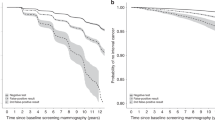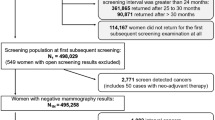Abstract
Objective
The European Commission Initiative on Breast Cancer recommendation for triennial screening of women aged 70–74 is based on very weak evidence. A cohort of Italian women who had their last biennial screening mammography at age 68–69 was followed up for 5 years, assumed to represent the interval to another hypothetical screening mammography, in order to determine the annual proportional incidence of interval breast cancer.
Methods
The cohort included 118,370 women. They had their last mammography between 1997 and 2008. Incident breast cancers were identified by record-linking the cohort with the regional breast cancer registry. The expected incidence in the age range 65–74 was estimated with an age-period-cohort model. The number of interval cancers was divided by the expected number to obtain their proportional incidence.
Results
Overall, there were 298,658 woman-years at risk with 371 interval cancers versus 988.8 expected. In the first, second, third, fourth, and fifth interval year, the proportional incidence was 0.09 (95% confidence interval, 0.06–0.13), 0.32 (0.25–0.39), 0.60 (0.49–0.73), 0.75 (0.60–0.92), and 0.81 (0.60–1.07), respectively. Between the second and the fifth year, tumour stage and molecular subtype did not change significantly.
Conclusion
Though not supported by these findings, the proposal of triennial screening for women aged 70–74 merits further research, because the 95% confidence interval of the third-year proportional incidence of interval cancer included 0.50—the maximum limit considered acceptable for women aged 50–69.
Key Points
• The third-year incidence of breast cancer relative to the expected one was 0.60 (95% confidence interval, 0.49–0.73).
• Between the second and the fifth year, tumour stage and molecular subtype did not change significantly (p >0.10).
• The proposal of a 3-year screening interval at age 70–74 merits further evaluation.
Similar content being viewed by others
Abbreviations
- APC:
-
Age-period-cohort
- ECIBC:
-
European Commission Initiative on Breast Cancer
- ER+:
-
Estrogen receptor-positive
- EXP:
-
Expected
- HER-:
-
Human epidermal growth factor receptor 2-negative
- HER+:
-
Human epidermal growth factor receptor 2-positive
- OBS:
-
Observed
- PR+:
-
Progesterone receptor-positive
References
European Commission (2018) European Commission Initiative on Breast Cancer. Available via https://healthcare-quality.jrc.ec.europa.eu/. Accessed 22 Apr 2021
European Commission (2018) Screening for women aged 70-74. Available via https://healthcare-quality.jrc.ec.europa.eu/european-breast-cancer-guidelines/screening-ages-and-frequencies/women-70-74. Accessed 22 Apr 2021
European Commission (2018) Screening frequency for women aged 70-74. Annual vs. biennial. Available via https://healthcare-quality.jrc.ec.europa.eu/european-breast-cancer-guidelines/screening-ages-and-frequencies/frequency-70-74/annual-vs-biennial. Accessed 22 Apr 2021
European Commission (2018) Evidence to decision: recommendation justification, considerations and assessment. Available via https://healthcare-quality.jrc.ec.europa.eu/sites/default/files/Guidelines/EtDs/ECIBC_GLs_EtD_frequency_70-74_3vs2.pdf. Accessed 22 Apr 2021
Bucchi L, Falcini F, Baraldi GP et al (2003) Integrating self-referral for mammography into organised screening: results from an Italian experience. J Med Screen 10:134–138
Bucchi L, Ravaioli A, Baldacchini F et al (2019) Annual mammography at age 45-49 years and biennial mammography at age 50-69 years: comparing performance measures in an organised screening setting. Eur Radiol 29:5517–5527
Ravaioli A, Foca F, Colamartini A et al (2010) Incidence, detection, and tumour stage of breast cancer in a cohort of Italian women with negative screening mammography report recommending early (short-interval) rescreen. BMC Med 8:11
Bucchi L, Foca F, Ravaioli A et al (2009) Receipt of adjuvant systemic therapy among patients with high-risk breast cancer detected by mammography screening. Breast Cancer Res Treat 113:559–566
Giuliani O, Mancini S, Puliti D et al (2016) Patterns and determinants of receipt of follow-up mammography and/or clinical examination in a cohort of Italian breast cancer survivors. Breast Cancer Res Treat 158:543–551
Cortesi L, Baldassarri B, Ferretti S et al (2020) A regional population-based hereditary breast cancer screening tool in Italy: first 5-year results. Cancer Med 9:2579–2589
Bucchi L, Ravaioli A, Foca F, Colamartini A, Falcini F, Naldoni C (2008) Incidence of interval breast cancers after 650,000 negative mammographies in 13 Italian health districts. J Med Screen 15:30–35
Ravaioli A, Mancini S, Naldoni C, Falcini F, Ferretti S, Bucchi L (2016) Coping with problems that flaw the estimate of mammography sensitivity in population-based screening programmes: the Italian perspective. Public Health 136:178–180
Bucchi L, Ravaioli A, Baldacchini F et al (2021) Incidence of interval breast cancer among women aged 45-49 in an organised mammography screening setting. J Med Screen 28:207–209
Sassoli de Bianchi P, Ravaioli A, Ferretti S et al (2017) Extension of the target age range of mammography screening programme and governance of mammography practice in the Emilia-Romagna Region (Northern Italy). Epidemiol Prev 41:38–45
Muratov S, Canelo-Aybar C, Tarride JE et al (2020) Monitoring and evaluation of breast cancer screening programmes: selecting candidate performance indicators. BMC Cancer 20:795
Broeders M, Nyström L, Ascunce N et al (2006) Epidemiological guidelines for quality assurance in breast cancer screening. In: Perry N, Broeders M, de Wolf C, Törnberg S, Holland R, von Karsa L (eds) European guidelines for quality assurance in breast cancer screening and diagnosis, 4th edn. Office for Official Publications of the European Communities, Luxembourg, pp 15–56
Bucchi L, Puliti D, Ravaioli A et al (2008) Breast screening: axillary lymph node status of interval cancers by interval year. Breast 17:477–483
Basu P, Ponti A, Anttila A et al (2018) Status of implementation and organization of cancer screening in The European Union Member States: summary results from the second European screening report. Int J Cancer 142:44–56
Vaccarella S, Franceschi S, Engholm G, Lönnberg S, Khan S, Bray F (2014) 50 years of screening in the Nordic countries: quantifying the effects on cervical cancer incidence. Br J Cancer 111:965–969
Bucchi L, Baldacchini F, Mancini S et al (2019) Estimating the impact of an organised screening programme on cervical cancer incidence: a 26-year study from northern Italy. Int J Cancer 144:1017–1026
Buiatti E, Barchielli A, Bartolacci S et al (2003) The impact of organised screening programmes on the stage-specific incidence of breast cancer in some Italian areas. Eur J Cancer 39:1776–1782
Bucchi L, Ravaioli A, Mancini S et al (2020) Detection by screening introduces biases into survival estimates for luminal A-like breast cancer patients. Int J Cancer 146:1764–1766
Aapro M, Wildiers H (2012) Triple-negative breast cancer in the older population. Ann Oncol 23(Suppl 6):vi52–vi55
Jacklyn G, Howard K, Irwig L, Houssami N, Hersch J, Barratt A (2017) Impact of extending screening mammography to older women: information to support informed choices. Int J Cancer 141:1540–1550
Mack DS, Lapane KL (2019) Screening mammography among older women: a review of United States guidelines and potential harms. J Women's Health (Larchmt) 28:820–826
Pisano ED, Hendrick RE, Yaffe MJ et al (2008) Diagnostic accuracy of digital versus film mammography: exploratory analysis of selected population subgroups in DMIST. Radiology 246:376–383
Song SY, Park B, Hong S, Kim MJ, Lee EH, Jun JK (2019) Comparison of digital and screen-film mammography for breast-cancer screening: a systematic review and meta-analysis. J Breast Cancer 22:311–325
Puliti D, Bucchi L, Mancini S et al (2017) Advanced breast cancer rates in the epoch of service screening: the 400,000 women cohort study from Italy. Eur J Cancer 75:109–116
Giudici F, Bortul M, Clagnan E et al (2020) Early effects of attendance to the Friuli Venezia Giulia (Northern Italy) mammography screening programme on the incidence of advanced-stage breast cancer: a cohort study. Epidemiol Prev 44(2-3):145–153
Acknowledgements
The members of the Emilia-Romagna Region Workgroup for Mammography Screening Evaluation are as follows: Stefano Ferretti (University of Ferrara and Local Health Authority, Ferrara, Italy); Nicoletta Bertozzi, Enza Di Felice, Alba Carola Finarelli, Carlo Naldoni, Priscilla Sassoli de Bianchi (Department of Health, Regional Administration, Emilia-Romagna Region, Bologna, Italy); Flavia Baldacchini, Lauro Bucchi, Orietta Giuliani, Silvia Mancini, Alessandra Ravaioli, Rosa Vattiato (Romagna Cancer Institute, IRST, IRCCS, Meldola, Forlì, Italy); Fabio Falcini (Romagna Cancer Institute, IRCCS IRST “Dino Amadori”), Meldola, Forlì, and Local Health Authority, Forlì, Italy); Elisabetta Borciani, Giorgio Celoni, Giorgio Gatti, Rosella Schianchi (Local Health Authority, Piacenza, Italy); Nicoletta Piazza, Marella Zatelli (Local Health Authority, Parma, Italy); Paolo Giorgi Rossi (Epidemiology Unit, Azienda Unità Sanitaria Locale – IRCCS di Reggio Emilia, Reggio Emilia, Italy); Cinzia Campari, Antonella Cattani, Luisa Paterlini (Cancer Screening Unit, Azienda Unità Sanitaria Locale – IRCCS di Reggio Emilia, Reggio Emilia, Italy); Carlo Alberto Mori, Rita Vacondio (Cancer Screening Unit, Azienda Unità Sanitaria Locale – IRCCS di Reggio Emilia, Reggio Emilia, Italy); Valeria Bellelli, Giuliano Carrozzi, Rossella Corradini, Claudia Mauri, Rossella Negri (Local Health Authority, Modena, Italy); Carmen Bazzani, Marilena Manfredi, Francesca Mezzetti, Adriana Pasquini, Gianni Saguatti (Local Health Authority, Bologna, Italy); Licia Caprara, Stefania Cortecchia, Margherita De Lillo, Roberto Nannini (Local Health Authority, Imola, Italy); Giorgio Benea, Aldo De Togni, Caterina Palmonari, Roberto Pasqualini (Local Health Authority, Ferrara, Italy); Patrizia Bravetti, Monica Serafini, Benedetta Vitali (Local Health Authority, Ravenna, Italy); Antonella Bagni, Claudia Imolesi, Mauro Palazzi (Local Health Authority, Cesena, Italy); Debora Canuti, Lorenzo Menghini, Giancarla Monticelli (Local Health Authority, Rimini, Italy).
Funding
The authors state that this work has not received any funding.
Author information
Authors and Affiliations
Consortia
Corresponding author
Ethics declarations
Guarantor
The scientific guarantor of this publication is Lauro Bucchi.
Conflict of interest
The authors of this manuscript declare no relationships with any companies whose products or services may be related to the subject matter of the article.
Statistics and biometry
Three of the authors have significant statistical expertise.
Informed consent
Written informed consent was not required for this study because of its retrospective nature.
Ethical approval
Institutional Review Board approval was obtained.
Methodology
• Retrospective
• Observational
• Multicenter study
Additional information
Publisher’s note
Springer Nature remains neutral with regard to jurisdictional claims in published maps and institutional affiliations.
Supplementary information
ESM 1
Age-period-cohort models for trends in incidence of breast cancer in Emilia-Romagna region from 1992 to 2008 (population aged 40–79 years) (DOCX 119 kb)
Rights and permissions
About this article
Cite this article
Bucchi, L., Ravaioli, A., Baldacchini, F. et al. Five-year annual incidence and clinico-molecular features of breast cancer after the last negative screening mammography at age 68–69. Eur Radiol 32, 834–841 (2022). https://doi.org/10.1007/s00330-021-08129-9
Received:
Revised:
Accepted:
Published:
Issue Date:
DOI: https://doi.org/10.1007/s00330-021-08129-9




